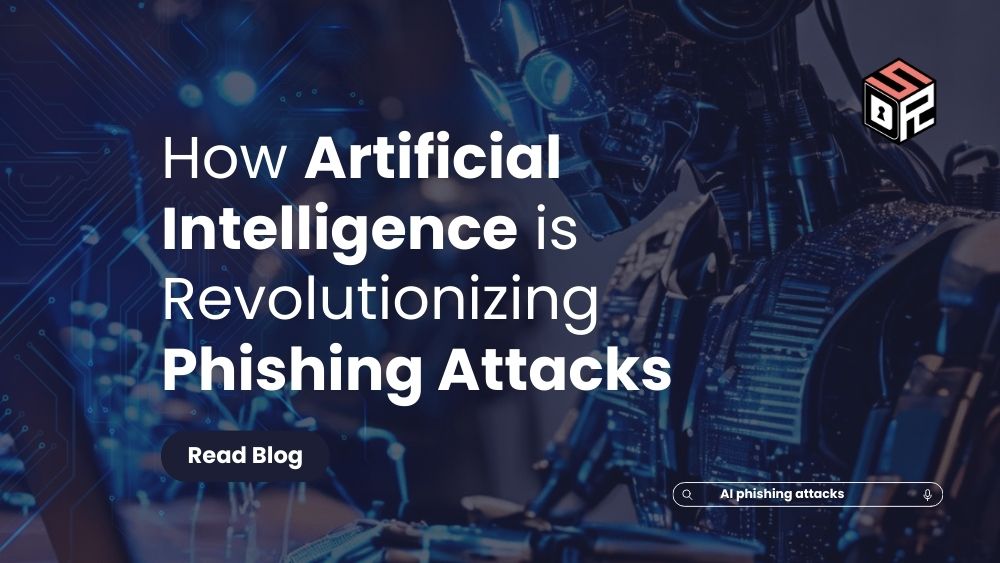Phishing attacks have long been a major concern for enterprise organizations wordwide. As technology continues to advance, cybercriminals are finding new and innovative ways to exploit vulnerabilities and deceive unsuspecting individuals.
In recent years, there has been a significant increase in QR code phishing attacks, also known as “quishing” attacks. These attacks have become hot on the latest phishing news and are a top concern for cybersecurity teams worldwide.
This article will delve into the latest trends in cyber phishing attacks, with a particular focus on the role of artificial intelligence (AI) in facilitating these malicious activities.
The Evolution of Phishing Attack Payloads: New Tricks for Old Scams
Phishing attacks, a mainstay in the cybercriminal’s arsenal, are constantly adapting to bypass security measures and exploit human vulnerabilities. Here’s a breakdown of some key trends transforming the phishing landscape:
The Rise of the QR Code: Forget suspicious links – QR codes are becoming a popular phishing tactic. In 2021, these were a mere blip, representing only 0.8% of attacks. Fast forward to 2023, and a staggering 12.4% of phishing attempts used QR codes. This trend continues in 2024, with 10.8% of attacks so far leveraging these seemingly innocuous squares. Be wary of scanning QR codes from unknown sources, especially those in emails or on suspicious websites.
Social Engineering on Steroids: Cybercriminals are increasingly turning to social engineering, the art of psychological manipulation. This tactic, now accounting for a whopping 19% of phishing attacks, involves creating a sense of urgency, trust, or fear to trick victims into revealing personal information or clicking malicious links. Be cautious of emails that pressure you to act immediately or play on your emotions.
AI-Generated Content: A Wolf in Sheep’s Clothing: The average phishing email length has tripled since 2021. This dramatic increase might be due to the use of generative AI, a technology that allows attackers to create more believable and personalized emails. Don’t be fooled by seemingly well-written content – scrutinize the sender’s address, grammar, and overall message for inconsistencies.
Moving Beyond Attachments: Attachment-based attacks are on the decline. Cybercriminals, aware of increased wariness around attachments, are shifting tactics. This highlights the importance of remaining vigilant against all forms of phishing attempts, not just those with attachments.
Multi-Channel Cyber Phishing Attacks Through Popular Messaging Platforms
Following initial phishing email attacks, cybercriminals often employ multi-channel strategies by exploiting popular messaging platforms, to maximize their chances of success.
These messaging platforms have gained popularity among cybercriminals due to their perceived legitimacy and the heavy focus on email-based attack awareness training.
According to the recent data collected from latest phishing news, Microsoft Teams and Slack account for 50% of the multi-channel attacks.
In 2024, Microsoft Teams experienced a 104.4% increase compared to the last three months of 2023, indicating its growing prominence as a target for phishing attacks.
Beyond the Script: The Rise of AI-Powered Phishing Attacks
Artificial intelligence has emerged as a powerful tool for cybercriminals, enabling them to carry out sophisticated attacks with greater efficiency.
Deepfakes, which involve the use of AI-generated audio and video to impersonate individuals, have become increasingly prevalent in phishing attacks.
In the first quarter of 2024, there was a 33.3% increase in the use of Zoom and a 31.3% increase in mobile phone calls as the second step in multi-channel attacks.
Researchers predict that the use of video and audio deepfakes will continue to rise in the coming months.
Generative AI is also expected to play a significant role in increasing the success rate of phishing attacks.That is because cybercriminals can now use generative AI to effortlessly create various payloads, including malware, phishing websites, and fraudulent invoices for wire fraud attacks.
By streamlining their processes and delivering more efficient campaigns, cybercriminals can now maximize their impact and financial gains.
AI Phishing Breaches Evade Security Email Gateways (SEGs) – Time to Rethink Your Strategy
Security email gateways (SEGs) are commonly used to detect and prevent phishing attacks. However, cybercriminals have developed obfuscation techniques that can bypass SEGs, making them less effective against certain types of ohishing attacks.
Two prevalent obfuscation techniques are hijacking legitimate hyperlinks and masking hyperlinks within image-based attachments like JPEGs.
These techniques, which make up 45.5% of obfuscation methods, are increasingly popular for evading detection.
A recent report highlights the alarming increase in the number of attacks that bypass security email gateways (SEGs). In the first three months of 2024, there was a staggering 52.2% rise in the number of attacks that successfully evaded SEG detection.
What’s even more concerning is that 68.4% of these attacks managed to pass authentication checks, including DMARC, which is a primary detection capability used by SEGs.
Targeting the Vulnerable: Millennials and Industry Hotspots in Phishing
Phishing attacks aren’t a one-size-fits-all scheme. Cybercriminals constantly analyze trends to target specific demographics and industries for maximum impact. Here’s a breakdown of two key areas where phishing attempts are particularly prevalent:
1. Targeting Millennials:
- A Generation on the Rise: According to an analysis, Millennials have become the primary target for phishing attacks, accounting for a staggering 37.5% of all phishing emails. This might be due to several factors – Millennials are generally comfortable with technology and may be less suspicious of certain online interactions.
2. Industry Hotspots:
- Finance, Legal, and Healthcare in the Crosshairs: Cybercriminals often target specific industries where they can potentially gain access to valuable data. The finance, legal, and healthcare sectors are the most frequently targeted, with individuals working in accounting and finance teams receiving the highest number of phishing emails. This is likely because these teams often handle sensitive financial information.
Beyond the Numbers: Impersonation Tactics
- Fake Bosses, Real Threats: Phishing emails often involve impersonation, where attackers pose as someone the victim knows or trusts. Interestingly, the analysis reveals that CEOs and senior leadership are impersonated in 13.4% of cases where the victim recognized the sender’s name. This highlights the importance of scrutinizing emails for inconsistencies, even if the sender appears familiar.
Conclusion
Phishing in cybersecurity continue to pose a significant threat. As technology advances, cybercriminals are finding new ways to exploit vulnerabilities and deceive unsuspecting individuals.
The rise of AI in phishing attacks, particularly in the form of deepfakes and generative AI, has further complicated the fight against cyber phishing.
It is crucial for individuals and organizations to remain vigilant and implement robust cybersecurity measures, including backup and disaster recovery with immutability and air-gapping to protect against these evolving threats.
Additional Resources
For more information on phishing attacks and cybersecurity, you may find the following resources helpful:
- Cybersecurity and Infrastructure Security Agency (CISA)
- National Cybersecurity Centre (NCSC)
- Anti-Phishing Working Group (APWG)
- Phishing.org
Frequently Asked Question (FAQs)
How can AI detect phishing?
Artificial intelligence (AI) can play a crucial role in detecting phishing attacks by analyzing various patterns and indicators. AI algorithms can be trained on large datasets of known phishing emails, allowing them to learn the common characteristics and techniques used by cybercriminals. By leveraging machine learning and natural language processing, AI systems can identify suspicious email attributes, such as unusual sender addresses, misspelled words, and suspicious attachments or hyperlinks. Additionally, AI can analyze email headers, content, and metadata to detect anomalies and flag potential phishing attempts.
How does your cybersecurity approach address the threat of spear phishing attacks?
Preventing spear phishing attacks requires a multi-layered approach within your cybersecurity efforts. Here are key areas to focus on:
Employee Education and Awareness: Train employees to recognize signs of spear phishing attacks and provide ongoing cybersecurity training.
Email Filtering and Authentication: Implement robust email filtering systems and utilize technologies like SPF, DKIM, and DMARC to authenticate incoming emails.
Endpoint Protection: Deploy advanced endpoint protection solutions to detect and block malicious attachments and URLs.
Web Filtering and Content Inspection: Implement web filtering solutions to block access to malicious websites and perform regular content inspections.
Security Incident Response: Develop a robust incident response plan to handle spear phishing incidents effectively.
What are the common tactics used in spear phishing attacks?
Common tactics used in spear phishing attacks include email spoofing, personalization, pretexting, malicious attachments and links, and executive impersonation.
Why are targeted attacks like spear phishing successful?
Targeted attacks like spear phishing are successful due to social engineering techniques, sophistication, lack of awareness, limited security measures, and high-value targets.
Which industries are most targeted by phishing attacks?
The finance, legal, and healthcare industries are the most targeted sectors for phishing attacks.
How can artificial intelligence be used in phishing attacks?
Artificial intelligence can be used in phishing attacks in various ways. One of the prominent uses is the creation of deepfakes, where AI-generated audio and video are used to impersonate individuals and deceive targets. AI can also be used to generate various payloads, such as malware, phishing websites, and fraudulent invoices, to enhance the effectiveness of phishing campaigns.
Are security email gateways effective in preventing phishing attacks?
While security email gateways (SEGs) are commonly used to detect and prevent phishing attacks, cybercriminals have developed obfuscation techniques that can bypass these gateways. Techniques like hijacking legitimate hyperlinks and masking hyperlinks within image-based attachments have become increasingly popular for evading detection. This makes SEGs less effective against certain types of phishing attacks.
Who are the top targets for phishing attacks?
Millennials have emerged as the top targets for phishing attacks, receiving 37.5% of all phishing emails. Within specific industries, individuals working in accounting and finance teams are particularly targeted. Additionally, CEOs and senior leadership are often impersonated in phishing attacks, accounting for 13.4% of cases where the victim knew the impersonated individual.









